 |
Projects
SB2 Cepheids
Classical Cepheids
Type II Cepheids
Papers
by category
by first author
by target
Visitors so far: 35021.
Masses of classical Cepheids of 3 to 11 M⊙ are predicted by theory but those measured clump between 3.6 to 5 M⊙. As a result, their mass-luminosity relation is poorly constrained, impeding our understanding of basic stellar physics and the Leavitt Law. All Cepheid masses come from the analysis of 11 binary systems, including only 5 double-lined and well-suited for accurate dynamical mass determination. We started a project to analyze a new, numerous group of Cepheids in double-lined binary (SB2) systems to provide mass determinations in a wide mass interval and study their evolution.
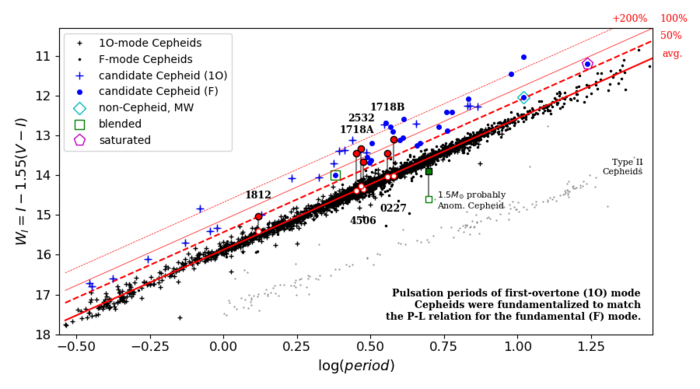
We analyzed a sample of 41 candidate binary LMC Cepheids spread along the P-L relation, that are likely accompanied by luminous red giants, and presented indirect and direct indicators of their binarity. In a spectroscopic study of a subsample of 18 brightest candidates, for 16 we detected lines of two components in the spectra (see Fig. 1), already quadrupling the number of Cepheids in SB2 systems. Observations of the whole sample may thus lead to quadrupling all the Cepheid mass estimates available now.
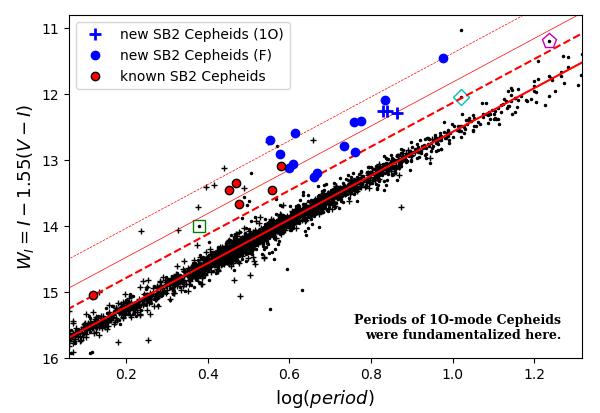

We report the discovery of a surprising binary configuration of the double-mode Cepheid OGLE-LMC-CEP-1347 pulsating in the first (P1=0.690d) and second overtone (P2=0.556d) modes. The orbital period (Porb=59d) of the system is five times shorter than the shortest known to date (310d) for a binary Cepheid. The Cepheid itself is also the shortest-period one ever found in a binary system and the first double-mode Cepheid in a spectroscopically double-lined binary.
OGLE-LMC-CEP-1347 is most probably on its first crossing through the instability strip, as inferred from both its short period and fast period increase, consistent with evolutionary models, and from the short orbital period (not expected for binary Cepheids whose components have passed through the red giant phase). Our evolutionary analysis yielded a first-crossing Cepheid with a mass in the range of 2.9-3.4 M⊙ (lower than any measured Cepheid mass), consistent with observations.
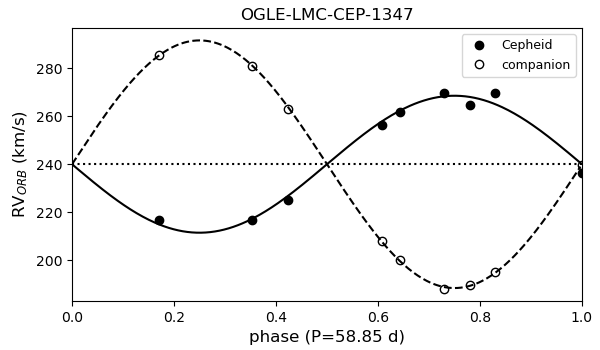
The companion is a stable star, at least two times fainter and less massive than the Cepheid (preliminary mass ratio q=0.55), while also redder and thus at the subgiant or more advanced evolutionary stage. To match these characteristics, the Cepheid has to be a product of binary interaction, most likely a merger of two less massive stars, which makes it the second known classical Cepheid of binary origin. Moreover, further evolution of the components may lead to another binary interaction.
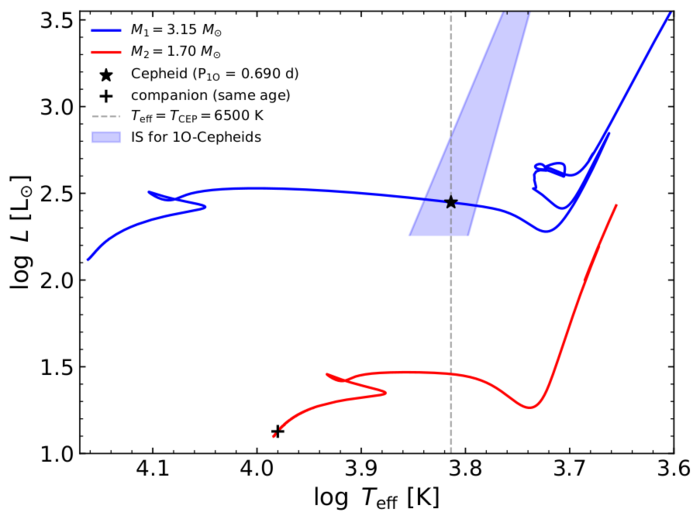
We confirmed spectroscopically binarity of nine double Cepheids, 2 in the LMC, 5 in the SMC and 2 in the Milky Way. This increased the number of known binary double (BIND) Cepheids from 1 to 10 and tripled the number of all confirmed double-lined binary (SB2) Cepheids. Thanks to these results we found the first empirical evidence that typical period–luminosity relations (PLRs) are rather binary Cepheid PLRs, as they include light of the companion. The statistics of pulsation period ratios of BIND Cepheids do not agree with those expected for pairs of Cepheids of the same age. These ratios together with the determined mass ratios far from unity suggest a merger origin of at least one component for about half of the systems.
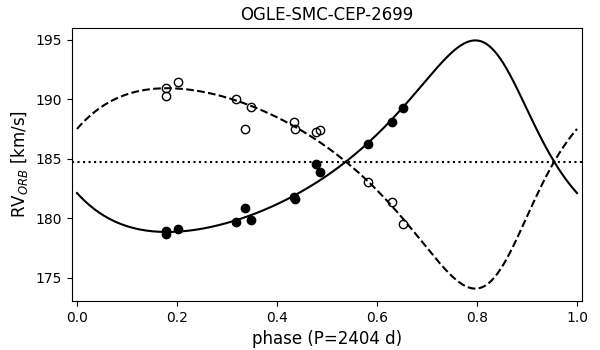
| Cepheids with giant companions. II. Spectroscopic confirmation of nine new double-lined binary systems composed of two Cepheids |
|---|
| Pilecki, B.; Thompson, I. B.; Espinoza-Arancibia, F.; Hajdu, G.; Gieren, W.; Taormina, M.; Pietrzyński, G.; Narloch, W.; Bono, G.; Gallenne, A.; Kervella, P.; Wielgórski, P.; Zgirski, B.; Graczyk, D.; Karczmarek, P.; Evans, N. R. |
| 2024, A&A, arxiv:2403.12390 - More information |
| Discovery of a binary-origin classical Cepheid in a binary system with a 59-day orbital period |
| Pilecki B., Thompson, I. B., Espinoza-Arancibia, F., Anderson R. I., Gieren W., Narloch W., Minniti, J., Pietrzyński G., Taormina M., Bono, G., Hajdu, G. |
| 2022, ApJL, 940, L48 - More information |
| Cepheids with giant companions. I. Revealing a numerous population of double-lined binary Cepheids |
| Pilecki B., Pietrzyński G., Anderson R., Gieren W., Taormina M., Narloch W., Evans N., Storm J. |
| 2021, ApJ, 910, 118 - More information |
| Cepheids with giant companions: A new, abundant source of Cepheid astrophysics |
|---|
| Bogumił Pilecki |
| 2024, Proceedings of the IAU, 376, 150 |
| Revealing a numerous population of double-lined binary Cepheids |
| Bogumił Pilecki |
| 2022, Proceedings of the PAS, 12, 174 |
| Fundamentalization of periods for first and second-overtone classical Cepheids |
|---|
| Pilecki B. |
| 2024, ApJL, 970, L14 - More information |
| Empirical instability strip for classical Cepheids. I. The Large Magellanic Cloud galaxy |
| Espinoza, F.; Pilecki, B.; Pietrzyński, G.; Smolec, R.; Kervella, P. |
| 2024, A&A, 682, 185 |
| Studies of RR Lyrae Variables in Binary Systems. I. Evidence of a Trimodal Companion Mass Distribution |
| Hajdu G., Pietrzyński G., Jurcsik J., Catelan M., Karczmarek P., Pilecki B., Soszyński I., Udalski A., Thompson I. |
| 2021, ApJ, 915, 50 |
We gratefully acknowledge financial support for this work from the Polish National Science Centre grant SONATA BIS 2020/38/E/ST9/00486.
